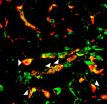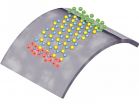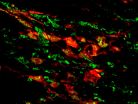(Press-News.org) This market effect erases the advantage of lower emissions from the natural gas itself, according to an unprecedented international comparison of computer simulations.
"The upshot is that abundant natural gas alone will not rescue us from climate change," says the lead author Haewon McJeon of the Department of Energy's Pacific Northwest National Laboratory (PNNL). Especially in the US advances such as hydraulic fracturing – pumping liquids into stone to break it up and release the gas, known as fracking – and horizontal drilling have led to bountiful natural gas production. "Global deployment of advanced natural gas production technology could double or triple the global natural gas production by 2050", McJeon says.
"The high hopes have been misguided" – market effects dominate
This might eventually lead to up to ten percent higher CO2 emissions by the middle of our century instead of lowering CO2 emissions. "The additional gas supply boosts its deployment, but the substitution of coal is rather limited and it might also substitute low-emission renewables and nuclear, according to our calculations," says co-author Nico Bauer of the Potsdam Institute for Climate Impact Research. "The high hopes that natural gas will help reduce global warming because of technical superiority to coal turn out to be misguided because market effects are dominating. The main factor here is that an abundance of natural gas leads to a price drop and expansion of total primary energy supply." This could lead to an overall increase of energy consumption and hence of emissions. Moreover, increased gas production comes with higher emissions of the powerful greenhouse gas methane from drilling leakages and pipelines.
The uncertainty surrounding gas supply is tremendous – the assessment of global natural gas resources have been revised over the past decade, but the economic implications up to now were not well understood.
Technological advances cannot replace climate policies
So five research groups from Germany, USA, Austria, Italy and Australia projected what the world might be like in 2050 with and without a natural gas boom. They used five different computer models that included not just energy use and production, but also the broader economy and the climate system. "When we first saw little change in greenhouse gas emissions in our model, we thought we had made a mistake, because we were fully expecting to see a significant reduction in emissions," said scientist James 'Jae' Edmonds of PNNL's Joint Global Change Research Institute. "But when we saw all five modeling teams reporting little difference in climate change, we knew we were onto something."
"The findings show that effective climate stabilization can be achieved only through emissions pricing – this requires international political cooperation and binding agreements," comments Ottmar Edenhofer, chief economist of PIK and co-chair of the working group on mitigation of the Intergovernmental Panel on Climate Change (IPCC) that recently published a milestone assessment report. "Technological advances can reduce the costs of climate policies – but they cannot replace policies."
INFORMATION:
Article: McJeon, H., Edmonds, J., Bauer, N., Clarke, L., Fisher, B., Flannery, B.P., Hilaire, J., Krey, V., Marangoni, G., Mi, R., Riahi, K., Rogner, H., Tavoni, M. (2014): Limited impact on decadal-scale climate change from increased use of natural gas. Nature (advance online publication) [DOI:10.1038/nature13837]
Weblink to the article once it is published: http://dx.doi.org/10.1038/nature13837
For further information please contact:
PIK press office
Phone: +49 331 288 25 07
E-Mail: press@pik-potsdam.de
Twitter: @PIK_Climate
Natural gas boom will not slow climate change
2014-10-15
ELSE PRESS RELEASES FROM THIS DATE:
Discovery of heart's repair process suggests new treatment strategy for heart attack
2014-10-15
UCLA researchers have discovered that some scar-forming cells in the heart, known as fibroblasts, have the ability to become endothelial cells — the cells that form blood vessels. The finding could point the way toward a new strategy for treating people who have suffered a heart attack, because increasing the number of blood vessels in the heart boosts its ability to heal after injury.
In studies involving mice, the UCLA team also found that a drug could enhance this phenomenon and improve the repair process after a heart attack.
The research is published in the ...
Researchers develop world's thinnest electric generator
2014-10-15
New York, NY—October 15, 2014—Researchers from Columbia Engineering and the Georgia Institute of Technology report today that they have made the first experimental observation of piezoelectricity and the piezotronic effect in an atomically thin material, molybdenum disulfide (MoS2), resulting in a unique electric generator and mechanosensation devices that are optically transparent, extremely light, and very bendable and stretchable.
In a paper published online October 15, 2014, in Nature, research groups from the two institutions demonstrate the mechanical ...
UNC researchers boost the heart's natural ability to recover after heart attack
2014-10-15
CHAPEL HILL – Researchers from the UNC School of Medicine have discovered that cells called fibroblasts, which normally give rise to scar tissue after a heart attack, can be turned into endothelial cells, which generate blood vessels to supply oxygen and nutrients to the injured regions of the heart, thus greatly reducing the damage done following heart attack.
This switch is driven by p53, the well-documented tumor-suppressing protein. The UNC researchers showed that increasing the level of p53 in scar-forming cells significantly reduced scarring and improved heart ...
Post-tonsillectomy complications more likely in kids from lower-income families
2014-10-15
Removing a child's tonsils is one of the most common surgeries performed in the United States, with approximately 500,000 children undergoing the procedure each year. New research finds that children from lower-income families are more likely to have complications following the surgery.
In the first study of its kind to analyze post-operative complications requiring a doctor's visit within the first 14 days after tonsillectomy, researchers saw a significant disparity based on income status, race and ethnicity.
"Surprisingly, despite all children having a relatively ...
Tuning light to kill deep cancer tumors
2014-10-15
WORCESTER, MA – An international group of scientists led by Gang Han, PhD, at the University of Massachusetts Medical School, has combined a new type of nanoparticle with an FDA-approved photodynamic therapy to effectively kill deep-set cancer cells in vivo with minimal damage to surrounding tissue and fewer side effects than chemotherapy. This promising new treatment strategy could expand the current use of photodynamic therapies to access deep-set cancer tumors.
"We are very excited at the potential for clinical practice using our enhanced red-emission nanoparticles ...
Discovery of a new mechanism that can lead to blindness
2014-10-15
Montréal, October 15, 2014 – An important scientific breakthrough by a team of IRCM researchers led by Michel Cayouette, PhD, is being published today by The Journal of Neuroscience. The Montréal scientists discovered that a protein found in the retina plays an essential role in the function and survival of light-sensing cells that are required for vision. These findings could have a significant impact on our understanding of retinal degenerative diseases that cause blindness.
The researchers studied a process called compartmentalization, which establishes ...
Blinded by science
2014-10-15
Do you believe in science? Your faith in science may actually make you more likely to trust information that appears scientific but really doesn't tell you much. According to a new Cornell Food and Brand Lab study, published in Public Understanding of Science, trivial elements such as graphs or formulas can lead consumers to believe products are more effective. "Anything that looks scientific can make information you read a lot more convincing," says the study's lead author Aner Tal, PhD, "The scientific halo of graphs, formulas, and other trivial elements that look scientific ...
Weather history time machine
2014-10-15
During the 1930s, North America endured the Dust Bowl, a prolonged era of dryness that withered crops and dramatically altered where the population settled. Land-based precipitation records from the years leading up to the Dust Bowl are consistent with the telltale drying-out period associated with a persistent dry weather pattern, but they can't explain why the drought was so pronounced and long-lasting.
The mystery lies in the fact that land-based precipitation tells only part of the climate story. Building accurate computer reconstructions of historical global precipitation ...
Change your walking style, change your mood
2014-10-15
Our mood can affect how we walk — slump-shouldered if we're sad, bouncing along if we're happy. Now researchers have shown it works the other way too — making people imitate a happy or sad way of walking actually affects their mood.
Subjects who were prompted to walk in a more depressed style, with less arm movement and their shoulders rolled forward, experienced worse moods than those who were induced to walk in a happier style, according to the study published in the Journal of Behavior Therapy and Experimental Psychiatry.
CIFAR Senior Fellow Nikolaus ...
New guideline in genetic testing for certain types of muscular dystrophy
2014-10-15
Rochester, Minn. – The American Academy of Neurology (AAN) and the American Association of Neuromuscular & Electrodiagnostic Medicine (AANEM) offer a new guideline on how to determine what genetic tests may best diagnose a person's subtype of limb-girdle or distal muscular dystrophy. The guideline is published in the October 14, 2014, print issue of Neurology®, the medical journal of the AAN.
Researchers reviewed all of the available studies on the muscular dystrophy, a group of genetic diseases in which muscle fibers are unusually susceptible to damage, as ...



